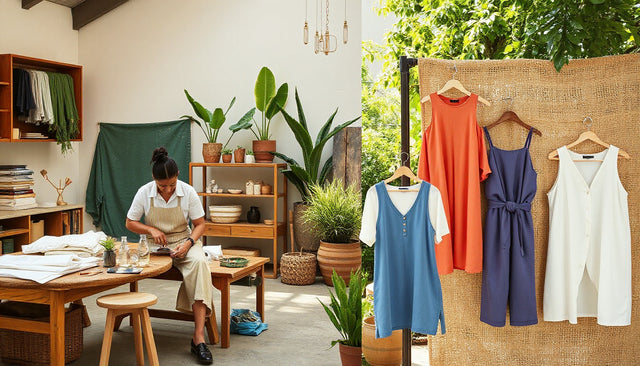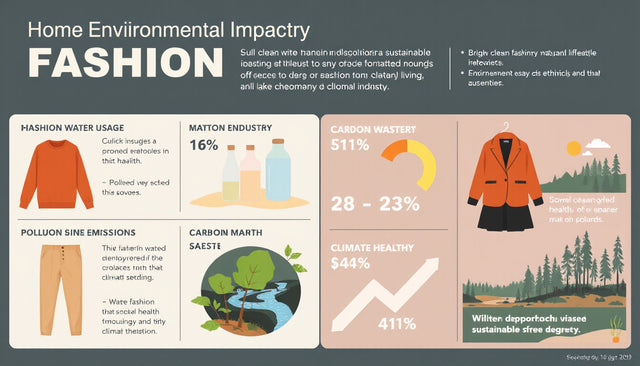Fashion is not only style. It links directly to our planet’s health. The clothes you wear add stress to nature. When you understand this impact, you can choose better. You can protect Earth without giving up style.

What Is the Climate Impact of Clothing?
Making clothes, especially through fast fashion, hurts nature. Fast fashion means quick, cheap production of trendy clothes. This process harms the environment in many ways:
- Carbon Emissions: The fashion world makes 8–10% of the world’s carbon output. This total exceeds the emissions from all international flights and ocean shipping.
- Water Consumption: One cotton T-shirt needs about 700 to 2,700 liters of water. That amount can serve one person for 2.5 years.
- Pollution: Dyeing textiles is the second biggest source of water pollution. Wastewater from dyeing clouds rivers and hurts life.
- Microplastics: Washing fake-fiber clothes lets hundreds of thousands of tiny plastic fibers drop into water. These fibers build up in oceans and in our food.
- Waste: Each year, 85–90% of clothes end up in landfills or get burned. Only 1% goes back to become new clothes.
Why Fast Fashion Hurts the Planet
Fast fashion labels like Zara, H&M, and Shein use a quick system to design, make, and move new clothes in days or weeks. This low-cost system often leads to problems:
- Overproduction: Many clothes cause waste when unsold items pile up.
- Resource Depletion: Cutting down water, using too much land and oil in cotton farming and making fake fibers harms nature.
- Environmental Degradation: Dyeing uses toxic chemicals that spoil water and soil. This endangers nature and local groups.
- Social Issues: Many clothes are produced in factories with unsafe work and low pay. Some even use forced labor.
How the EU and Other Organizations Are Responding
Leaders and groups now act to fix these issues:
- The European Union sets strict rules. They stop waste by banning the destruction of unsold clothes from 2026. They push for eco-design, which means making clothes that last, are easy to fix, and can be recycled.
- The UN’s Alliance for Sustainable Fashion works to stop practices that hurt nature and people.
- Many brands now launch sustainable collections using organic or recycled fibers. Yet, real change comes if we all buy less.
How You Can Help Reduce Your Wardrobe's Climate Impact
Your choices matter. See how you can help:
1. Buy Less, Choose Better
- Limit your new clothes to items that are built to last. Some research says that buying no more than eight new items a year can cut emissions by up to 37% in big cities.
- Pick classic designs and quality fabrics, such as organic cotton, linen, hemp, or recycled fibers.
2. Embrace Slow Fashion
- Choose brands that care about workers, use eco-friendly materials, and keep their process clear.
- Skip trends that push for more waste or quick changes in style.
3. Shop Second-Hand and Swap
- Extend a garment’s life by buying from thrift shops or using sites like eBay, Poshmark, or ThredUp.
- Swap clothes with friends or local groups to get new looks without buying more.
4. Rent or Lease Clothes for Special Occasions
- Renting, such as through Rent the Runway, gives you new choices with less waste.
5. Care for Your Clothes
- Wash clothes less often and use cold water. This can cut down on microplastic fibers.
- Fix or alter garments instead of throwing them away.
Takeaway: Fashion Can Be a Force for Good
Seeing the hidden cost of fashion makes you a mindful buyer. The industry is changing because people now demand care for the planet and fair work practices.
When you value quality and care for your clothes, you help lower fashion’s impact on the climate. In this way, less truly becomes more—for fashion and for our planet.
Ready to make your wardrobe a little greener? Start by checking what you truly need, explore second-hand options, and share your journey toward sustainable fashion with others.
At Design Delight Studio, we’re committed to sustainable living and ethical fashion. Every article reflects our passion for mindful choices that empower both people and the planet.






















0 条评论